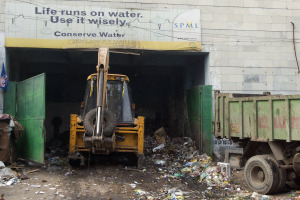In 2005, the World Bank estimated that roughly 42 per cent of people in India live below the poverty line. That poverty line lay at 26 Rupees (around $53) in 2011 (source: Guardian)and has more often been described as a “starvation line.” For huge amounts of people, it is a daily struggle to maintain themselves, even if they are fortunate to have a job in the first place.

Without proper ways to earn an income people need to find another way to sustain themselves. This little boy in the streets of Kashambi, New Delhi, has found a pack of cookies in a garbage pile.

In November 2011, India voted to allow 51% FDI (Foreign Direct Investment) into the country in the hope to improve India’s overall economic situation. However, the decision will also allow foreign investors, especially the world’s largest retailer WalMart, more control over India.
After the decision, opposition in the population grew strong. Indians fear that the foreign investors will overflow India’s market with subsidized (agricultural) products from Europe and America that will kill small farmers and businesses in India and increase the economic divide between rich and poor in the country.
The government decision is currently (Jan 2012) suspended due to opposition from various political quarters.

Cows are holy in India and feeding them brings good luck. Fresh and nutritious food is not always available, however. Their owners let the cows roam free during the day, hoping people will feed them. They return “home” to be milked.

At Jama Masjid Market in New Delhi, home and store, dirt and product, vendor and customer become nearly indistinguishable in the grey dust.

Living under the poverty line, street children in Panjim, Goa, come to Asha Deep (“Light & Hope”) Day Care and Night Shelter. There, they receive food, clothes, shelter and classes such as reading, writing and music (this is a music class with some children singing).

In a society grown out of a caste system that traditionally deemed those handling dirt and waste “untouchable”, educating people about recycling and waste management can be a challenge. Despite secularization (the “untouchables are today called Dalit), dirt handlers are still looked down upon.
This is a dumpster like many others right in the city of Delhi. Most trash, however, is simply thrown on the ground.
